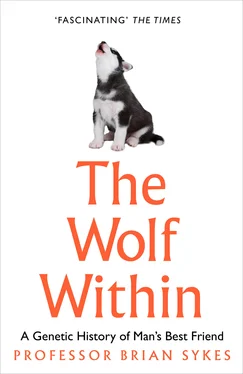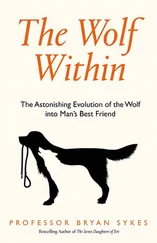Darwin wasn’t wrong about much, but, by means he could never have foretold, his statement on dogs that ‘We shall probably never be able to ascertain their origin with certainty’ would turn out to be one of those rare exceptions. I am sure he would have been utterly delighted to be proved wrong.
Turn the clock forward another ten years to the present day and the Wayne dog tree is still alive. But, like the technical improvements we have considered in the decade between the Wilson and Wayne papers, there have been great strides in DNA analysis in the last ten years, which have led to some radical pruning of the original tree, while leaving the major branches intact.
Before we turn to the effect of these improvements in filling in the blanks in our knowledge of dog evolution there is one other important genetic system to consider. This is the Y-chromosome, the mirror image of mDNA in a genealogical sense in that it traces not the maternal but the paternal genealogy through time. Again the reason is simple enough. Only males have Y-chromosomes and they pass them on exclusively to their male offspring. In many species it is a less reliable witness than the mitochondrial equivalent because of the very variable mating success of males. In most species, including our own, males have the potential to father virtually unlimited numbers of offspring, or none at all, but females are restricted to just a few. This has major implications when we come to look at pedigree dogs.
Just as any conclusion about evolution based on mitochondria should carry the caveat that it can only reveal patterns based on females, so the Y-chromosome only traces the origins of males. Of course, ultimately they both have to tell more or less the same story, but there are fascinating twists and turns along the way.
In any sort of genetic analysis it is vital to be able to detect inherited variation, which is the lifeblood of genetics. Variation comes in many different forms – blood groups, hair colour, height or DNA sequence. You simply can’t do any genetics without it. For DNA the variation in sequence can be read directly, as it is for most mDNA comparisons, or it can use what are known as genetic markers. These are places where the sequence between, in this case, different Y-chromosomes, is known to differ. You can then test for the markers directly without having to sequence the whole chromosome, which saves a lot of time and money. But before you can use them you have to find them, which used to be an enormous bore. It is much better now, as we shall see.
The tedious process of discovering dog and wolf Y-chromosome markers was slow to get going and the first studies used a panel of only four markers. Luckily Y-chromosomes alone are spared the process of shuffling with other chromosomes, something else I will explain as we go along, and so the markers can be combined as blocks. So four markers (A–D), with two versions at each one (1 or 2), can differentiate sixteen Y-chromosomes (A1, B2, C1, D2; A2, B1, C2, D1 and so on), meaning that you can do a lot with just four markers and sixteen combinations.
A group from Sweden was the first to publish any wolf and dog results from this kind of analysis, having studied both Y-chromosomes and mitochondria in 314 dogs from 109 different pedigree breeds.4 Their wolves came from six different regions in Europe and North America, a total of 112 animals. And of course, for both dogs and wolves, all the animals were males. It came as no great surprise after the Wayne mitochondrial pattern (as illustrated here) to find that the dog and wolf Y-chromosomes were similar. Also, there was no sign of any other species, as was always a formal possibility when only the mDNA results were known. Had the original dogs been hybrids between female wolves and male jackals, for example, this would have been invisible to mDNA analysis but not to that of the Y-chromosome. The confidence that wolves really were the only ancestors of all dogs increased substantially after the Swedish study.
In a similar fashion to mDNA, the same Y-chromosome, as defined by its genetic markers, was to be found in several different breeds of dog. As an example, an identical Y-chromosome was found in a Bernese mountain dog, a Border Collie, a Dalmatian, a Greyhound, a Poodle, a Shetland sheepdog and a West Highland terrier. On the other hand, different individual dogs of the same breed often had several different Y-chromosomes. Five Collies, for example, were found to have three different Y-chromosomes between them.
The comparison of the male and female genetic contributions showed quite clearly that in domestic dogs there were many more different mDNA sequences around than there were different Y-chromosomes. What that meant became clear when the wolf results were compared. In wolves the number of different mDNA and Y-chromosome sequences was about the same, not skewed as in dogs. This is very familiar scenario in many human populations where there are lots of different mDNA types but fewer Y-chromosomes than there should be if breeding success was roughly equal across the sexes.
Wolves are almost entirely monogamous, with only one breeding male and one breeding female in a pack. As a consequence males and females make an equal overall genetic contribution to successive generations and, as the Swedish team found, this balances the mDNA and Y-chromosome diversity. In pedigree dogs, the situation is more like some human populations where a few males have a disproportionate number of offspring. The ultimate human example is Genghis Khan, the thirteenth-century Mongol emperor who has an estimated 16 million male descendants living today, each of them carrying his Y-chromosome. Genghis Khan achieved this feat by slaughtering his male enemies defeated in battle and inseminating as many women as possible, often to the point of exhaustion. ‘Try spending the night alone from time to time,’ his doctors cautioned. When he died in 1127 Genghis passed on his wealth, and his habits, to his sons. Male dogs can achieve similar breeding success with considerably less effort than Genghis Khan. All they have to do is win ‘Best in Show’ and let the breeders do the rest.
At first it was a puzzle as to why pedigree breeds showed little or no sign of a common origin, at least as far as mDNA and Y-chromosomes were concerned. Surely with all the care taken to make sure pedigree dogs breed true, all dogs within a breed should have the same origins along both male and female ancestral lines. Not so. Instead, there seemed to be no telling, short of DNA testing, to which mDNA or Y-chromosome branch any particular dog belonged. Certainly, the breed could not be predicted from the DNA results from either system.
Although the scope of mDNA and the Y-chromosome is limited to just two genetic systems, we must not make the mistake of underestimating the importance of mitochondrial DNA and the Y-chromosome in crashing through the barriers of uncertainty surrounding the origin of the dog. Scientists from Darwin onwards have pondered this question with no means of coming to a definite conclusion. Were jackals or bush dogs or wolves or coyotes or foxes or hyenas or some other animal, possibly long extinct, the true ancestors of the modern dog? The research, first with mitochondrial DNA and then with the Y-chromosome, has made the answer crystal-clear. Wolves, and only wolves, are without question the ancestors of all living dogs.
4
The genetic trees drawn with the help of mitochondrial DNA and the Y-chromosome make it very clear that the only ancestor of all dogs is the wolf. There is more we can decipher from the DNA results, but before we come to that, what do we know about the ancestry of wolves?
The Age of the Mammals began in the Cretaceous period following the sudden extinction of the dinosaurs some 65 million years ago. This extinction left a big gap in the fauna which was gradually filled by mammals, which until then had been an inconspicuous group of small furry animals cowering in the undergrowth. Their numbers increased, and by 40 million years ago, during the Eocene epoch, the emerging mammals began to evolve into today’s familiar groups: horses, deer, elephants, apes, dogs and cats, early forms of modern Orders.
Читать дальше












